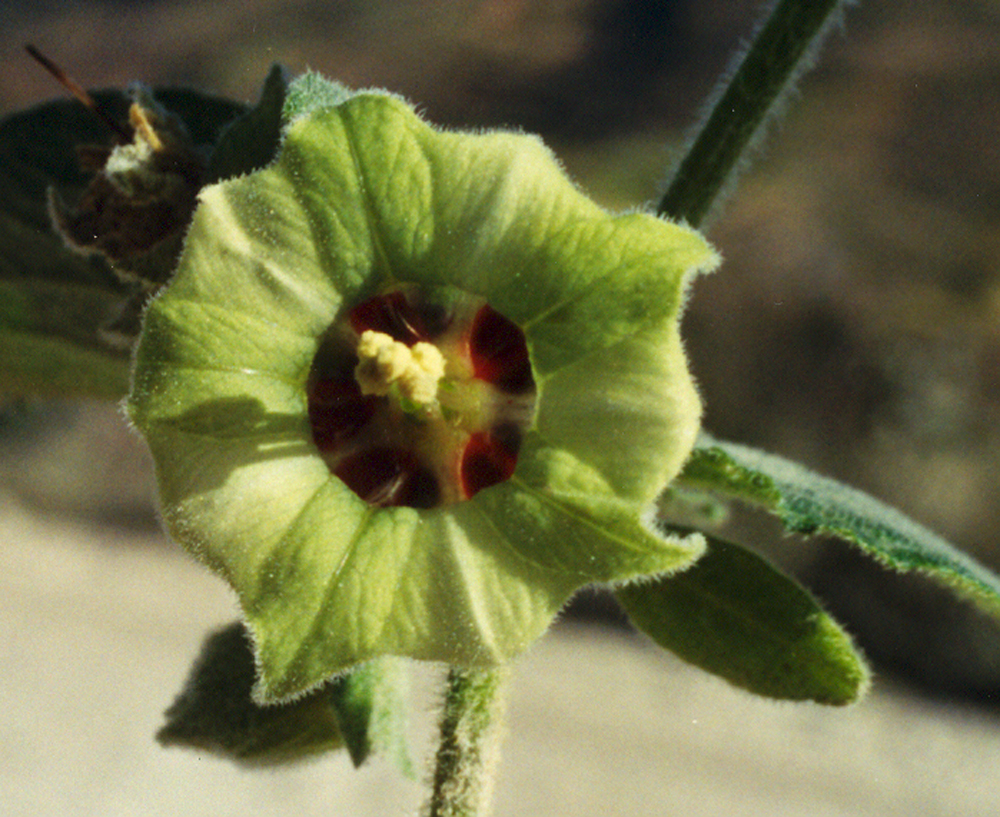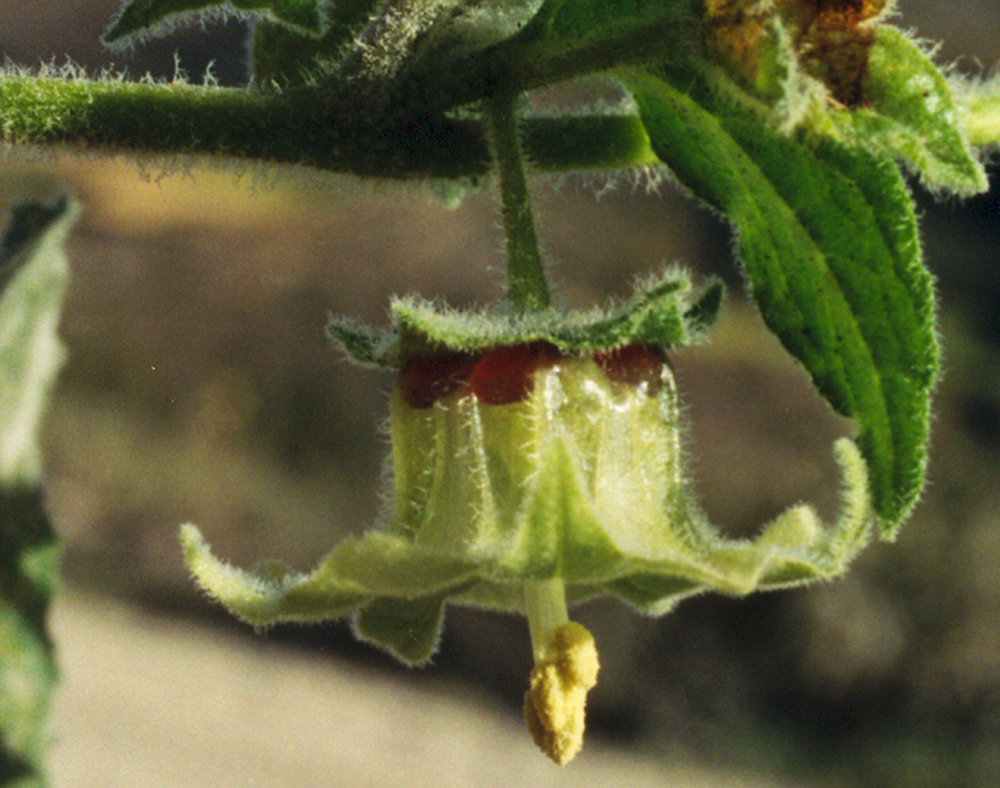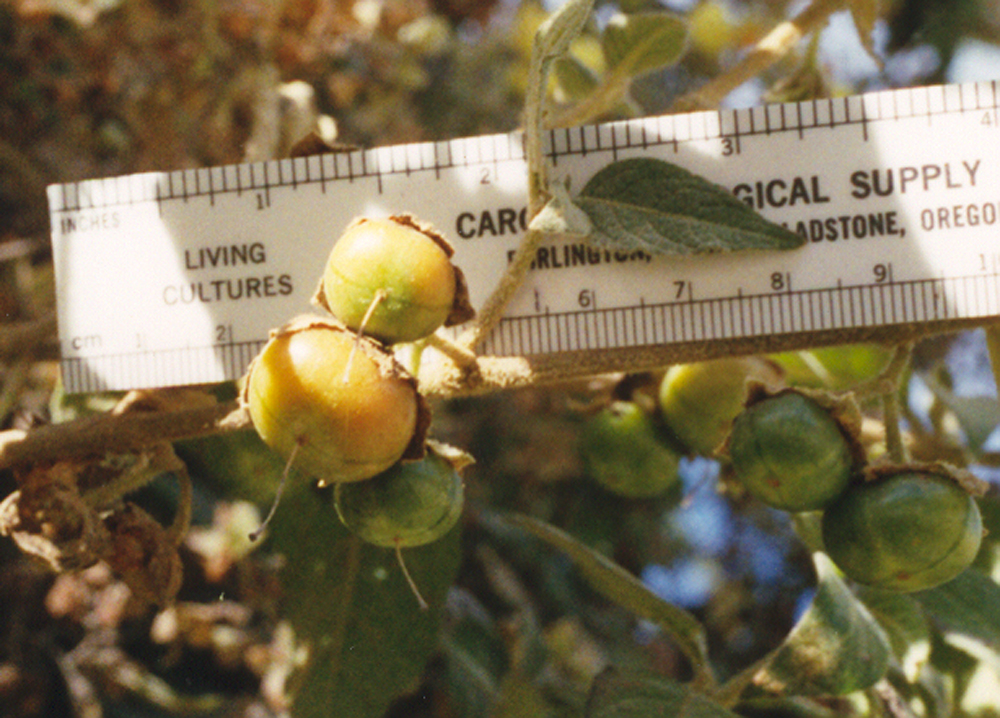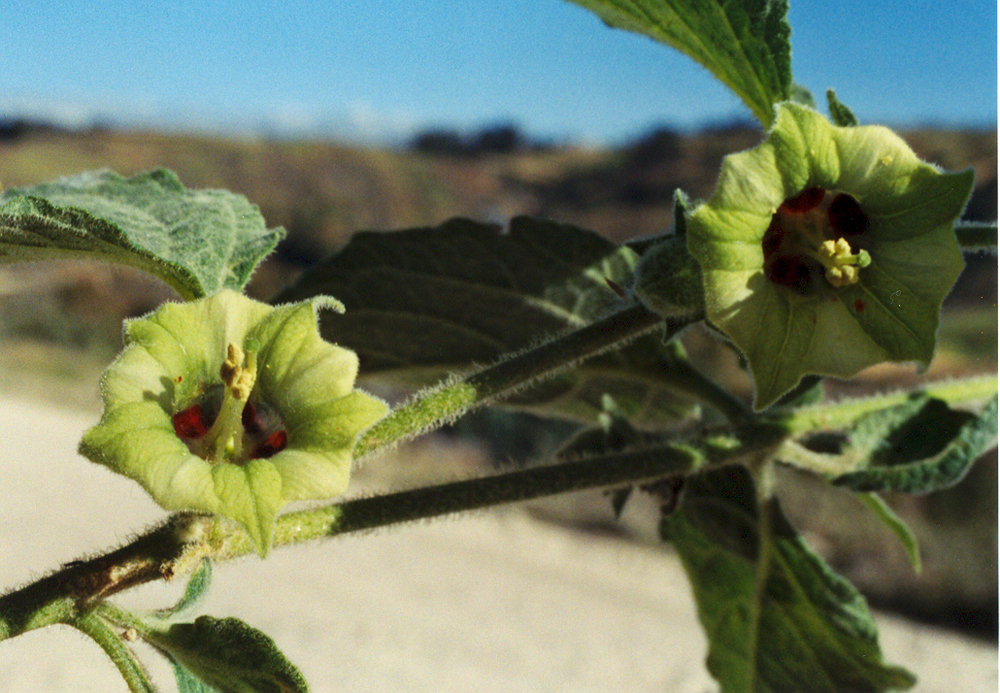| Character |
Description |
Figures on this page |
Habit & Height |
Perennial shrub to 1.5 m high |
|
Branches, young |
with a
dense vestiture of short, dendritic and unbranched, uniseriate
trichomes |
|
older |
|
|
| Leaves, size |
simple, to 6 cm long X 4 cm
wide |
|
| shape |
ovate, the
apex acute, the margin entire or subentire |
|
| hairs |
densely pubescent on both surfaces with intermixed
unbranched, forked, and dendritic trichomes to 0.5 mm long, the
trichomes never gland-tipped |
|
| petiole |
|
|
Inflorescence |
umbelliform, 3--4 (6) flowered;
infructescence one or two fruited |
|
peduncle |
axillary, 3--5 mm long, densely vestitured |
|
pedicel |
7--10
mm long, densely vestitured |
|
| Calyx when flowering, color and size |
13 mm in diameter during anthesis (flattened against ruler for
measuring), the lobes as long as wide, acuminate |
|
| shape / position during anthesis |
planar |
Figure 2 |
| hairs |
abaxially densely pubescent |
|
| at fruit maturity |
to 25 mm diameter |
|
Corolla color |
green, the lobes darker green than the lobules |
|
| green spots |
no |
|
| purple ring |
no |
|
| puple in base of corolla |
yes: "lila el 1/4 basal externa e interiormente" |
Leiva et al. 2016 |
shape and size |
campanulate with a revolute limb, 5 - 10 mm long X 23 - 25 mm in diameter when pressed, 30 - 35 mm diameter fresh |
|
lobes / lobules |
10: 5 lobes alternating with 5 smaller
lobules |
|
|
corolla veins with dendritic trichomes abaxially |
|
|
yes |
Figure 1 |
| Corona |
no |
|
Stamen length including anther |
5,
ultimately 9 - 10 mm long,
elongating at unequal rates according to my observations but S. Leiva (1998) wrote "filamentos iguales" and illustrated the stamens having equal lengths. |
|
| length stamens exserted beyond distal end of corolla |
|
|
| postion of stamens: a) before anthers dehisce, b) after anthers dehisce |
a & b: connivent for life of flower |
|
| base expanded laterally? |
|
|
| filaments |
pubescent at base, with unbranched or occasionally forked
trichomes to 0.6 mm long |
|
| anther color |
yellow with a green connective on outer face |
|
| anther size |
2.0--2.9 mm long prior to dehiscing, 1.5--1.6 mm long after
dehiscing |
|
| anther mucronate |
mucronulate |
observations made Aug 2013, flowers of Mione 533 preserved in ethanol. |
| insertion of filament into anther |
|
|
| anthers of a flower open simultaneously? |
|
|
| pollen quantity per flower |
61,000 - 121,000 |
|
| pollen grain size |
31.85--37 µm in diameter, mean 33.72 µm
(n= 23 grains) |
flowers were preserved in 70% ethanol; anthers were crushed in cotton blue (30 min); Mione 533 grown in Connecticut. |
| pollen grain size |
29.63--34.57 µm in diameter, mean 30.97 µm
(n= 23 grains) |
flowers were pressed and dried; anthers were crushed in cotton blue (30 min); wild plant, herbarium specimen Leiva & Guevara 1130 |
| corona |
no |
|
Stigma |
bilobed,
0.84--1.0 mm X 0.78--0.88 mm, exserted beyond anthers 1.5--4.5
mm |
|
Style length |
11 mm (measured on specimens pressed in Peru);
13 - 14 mm (Leiva 1998, probably a living specimen) |
|
Ovary |
|
|
Ovules per ovary |
110--180 per ovary |
|
| Nectar |
blood-red, copious |
|
| Herkogamy |
|
|
| Protogyny |
Anthers remain undehisced for a few hours
after anthesis. |
|
Fruit color (at maturity) and size |
orange, 12.5 X 19 mm |
(size based on one fruit measured in Peru Mione 705) |
Seeds per fruit |
300 |
(n = 1 fruit collected in Peru Mione 705) |
Seed Size |
1.52--1.68 mm long X 1.24--1.41 mm wide X 0.44--0.52 mm thick,
suborbicular to reniform, alveolate |
|
Chromosome number |
|
|
Growability in Connecticut, USA |
Easy to grow in a greenhouse |
|
How long does it take from flower to ripe fruit? |
|
|
Self-Compatible? |
Yes: A few fruits were set in a
pollinator-free greenhouse (without manual pollination) during
the spring of 1992. |
|
Seed Germination |
no data |
|
| Character |
Description of Jaltomata paneroi |
Figures on this web page |
Collections of Jaltomata paneroi including Geographic Distribution and Altitudes
Peru, Department Cajamarca (chronological order)
| Province |
Locality |
elevation
m |
habitat |
date |
collector (herbarium) |
| Cajamarca |
carretera Cajamarca-Celendín, aprox. 9 km NW de La
Encañada, frente al poblado de Quinuamayo |
3,324 |
very steep slope with acidic black soil, in an
area that is generally moist but somewhat dry in July and August |
2 Jul 1987 |
José
L. Panero, I. Sanchez, S. Leiva G. and C. Sagástegui 854 (HOLOTYPE: CONN; ISOTYPES: CPUN; specimens of plants grown from
seeds of the type collection were numbered as Mione 533: CONN, MO, NY). |
| |
|
|
|
|
|
| Cajamarca |
Jalca de Kumulca (ruta a Celendín) |
3,500 |
ladera |
17 Jun 1975 |
A. Sagástegui A. et al. 8111 (HUT, MO, NY) |
| Cajamarca |
Quinuamayo, entre La Encañada y jalca de Kumulca |
3,520 |
ladera con arbustos |
17 Jun 1975 |
I. Sánchez V. 1613 (F, CPUN) |
| Cajamarca |
La Encañada-Kumulca
(ruta a Celendín) |
3,240 |
sobre plantas de Rubus, al costado de carretera |
28 Jun 1994 |
S. Leiva G. & J. Guevara 1130 (F, HAO, HUT, US) |
| Cajamarca |
07 04.014 S
78 20.062 W |
no data |
among shrubs at roadside |
5 June 2005 |
S. Leiva G., T. Mione & L. Yacher 3315;
T. Mione, S. Leiva G. & L. Yacher 705 |



